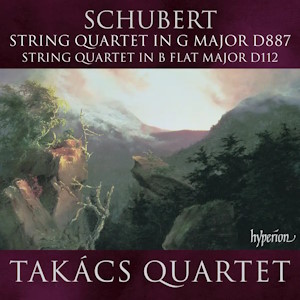
Franz Schubert (1797-1828)
String Quartet No. 15 in G major D887 (1826)
String Quartet No. 8 in B flat major D112 (1814)
Takács Quartet
rec. 2023, Concert Hall, Wyastone Estate, Monmouth, UK
Hyperion CDA68423 [78]
The pairing of Schubert’s last and greatest string quartet with one of his earlier works in the genre, written when he was 17 years old, makes an interesting programme. I have long favoured the live 1997 recording by the Alban Berg Quartet in the Mozartsaal, Vienna. The tempi here are similar and both quartets take the first movement repeats, so comparison between them seems apt.
The Takács Quartet offers a harsh, astringent sound, concomitant with the agitated, conflicted nature of the first movement – and I mean that entirely as a compliment; this is not music which begs for any sentimentality or Romanticism. The tremolos are febrile, haunted, ghostly and even menacing; the players are always wonderfully in tune and their deployment of dynamics is very telling, shadowing the violent mood swings of Schubert’s inspiration. The listener is never quite clear whether we are on the brink of despair of consolation and the intensity of the quartet’s playing mirrors that dilemma. The balance between the four instruments is ideal; it is the aural equivalent of watching a spotlight pick out in turn individual singers of an operatic quartet. The approach to tempi is quite free, allowing little surges without disrupting the unity of the movement. The climactic is ending is ferociously assertive. The ABQ have a slightly plusher, sweeter sound with a tad more vibrato and the live recording somewhat favours the two lower stringed instruments. Their reading of the first movement is more melancholy – sad rather than angry. Both approaches are equally valid, though in my current mood I favour the Takács’ more desperate execution over the ABQ’s more nuanced demeanour.
András Fejér’s sonorous cello comes to the fore in the opening march of the odd Andante. The very close recording unfortunately amplifies his breathing which can be a mite distracting, but the vehemence of the quartet’s playing is absorbing, even if I prefer in this movement the more lyrical style of the ABQ, who make more of the glissandos and are better balanced. The busy, scurrying, outer parts of the faintly unsettling Scherzo contrast neatly with the lilting, rocking motion of the Trio although I find the ABQ to be lighter on their feet – more Mendelssohnian, if you will – and more inclined to relax in the Trio compared with the Takács’ forcefulness. The bouncing, chattering Allegro finale is nimbly negotiated and brought to an exhilarating close.
The youthful quartet is of course a slighter affair but pure Schubert, astonishingly mature, with little hint in the first movement of it being derivative of his models, Haydn, Mozart and Beethoven, especially in the way the voices answer and intertwine and in the progression of keys – and above all, we hear that peculiar Schubertian gift for emotional ambivalence in the prevailing melodies and main themes. The second movement is, as Richard Wigmore’s erudite but accessible notes point out, more reminiscent of Haydn’s Seven Last Words but soon the melody assumes a typically Schubertian, floating grace, played here with none of the ferocity which characterises the Takács’ playing of the late quartet; this is a different world. The Menuetto is more rustic than courtly – again, Haydnesque – and played here with easy charm, even if the melody is rather facile and predictable. The most striking and original movement is the brief Presto finale in which the first violin skitters and scampers in a manner highly proleptic of the Scherzo of the ‘Great’ C major Symphony.
Ralph Moore
Buying this recording via a link below generates revenue for MWI, which helps the site remain free



















